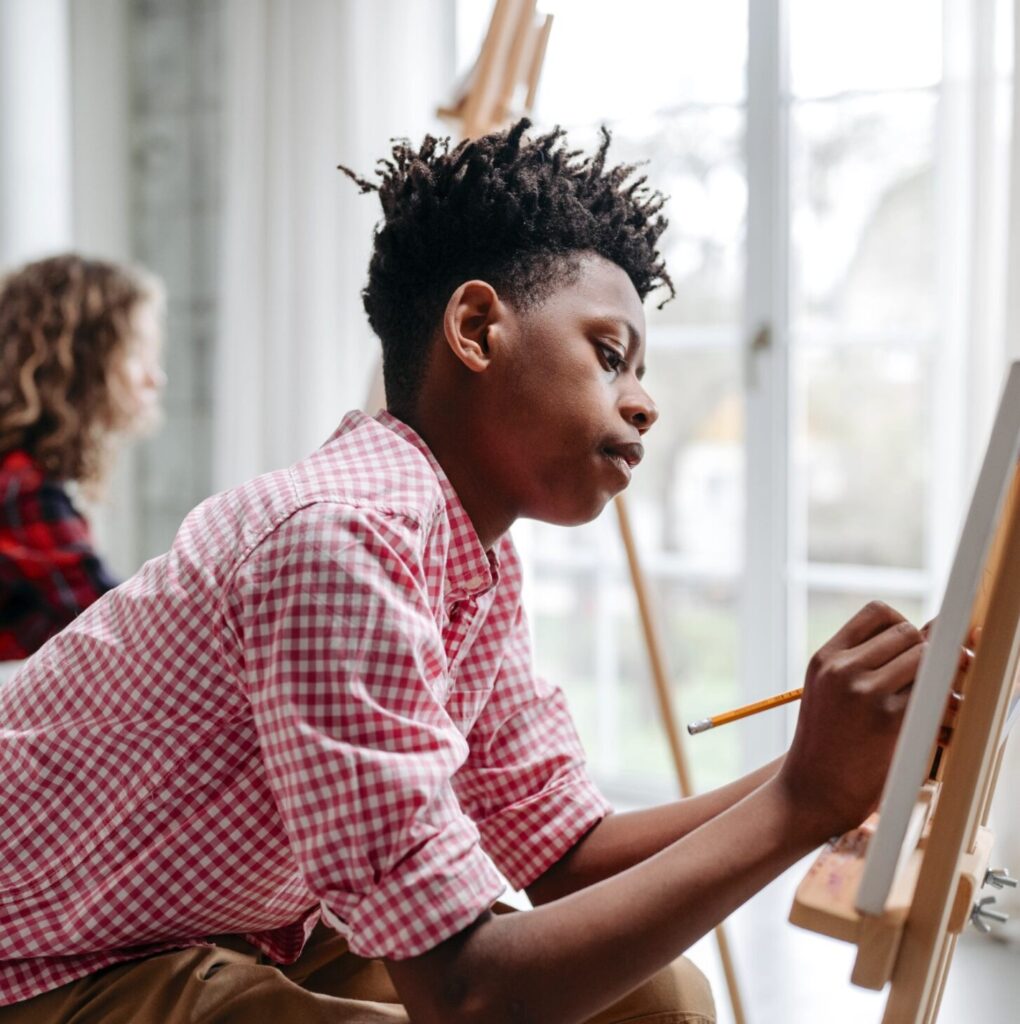
Can you remember how many times one of your students responded to your feedback, chose to revise their assignment on their own, and resubmitted it for a revised grade? For me, that answer is few to none. As this school year comes to a close, I have been reflecting about how I grade students in fifth and sixth grade art, and wondering if grades make a difference in students’ abilities as young artists. In Susan D. Blum’s book, Ungrading: Why Rating Students Undermines Learning (and What to Do Instead), she states, “The point is, when we grade, we really convey very little information about what is being assessed. But we can convey it in other, fuller ways” (2020, p. 12). What are some of these “fuller ways” to traditional grading and is there a standard grading system for art education? Is there a better way to assess student learning in art education?
Prepping the Canvas
I became an art teacher because I love teaching students what I love to do. As a career, education has been rewarding in so many ways. As an artist, I have enjoyed seeing what kids create, and as a teacher, I have loved seeing students gain confidence in their artistic abilities. I have found great professional satisfaction presenting at National Art Education Association (NAEA) and Michigan Art Education Association (MAEA) conferences, as well as writing articles for School Arts magazine. What I do not like about teaching, however, is having to grade students. Summative assessment is hard, and what I struggle with most often is, do my comments make a difference in the final outcome? Does what I have to say move students enough to revise their work? If so, great; but if not, why not? Do grades in art make a difference in the student’s artistic journey?
Over the years, I have been fortunate to have many students excel in art; whether it’s clay, painting, or digital design. Some kids have it from the start. So, I don’t worry about them; however, what about the students who struggle to even hold a pencil or who cannot use a ruler to draw a straight line? Should all students be held to the same standard? And if so, who decides that standard? And, if not, can we choose to not grade at all? Unfortunately, the answer to the latter is a simple “no” because in public education, we are required to assign grades.
Author Jesse Stommel (as cited in Blum, 2020, p. 28) makes the following comments about grades, “Grades are not good incentive….grades are not good feedback….grades are not good markers of learning….grades encourage competitiveness over collaboration….grades don’t reflect the idiosyncratic, subjective, often emotional character of learning…. finally, grades aren’t fair.” So, as a highly qualified certified art educator with 33 years of teaching experience, what am I going to do about grading? How can my grading system improve?
The Creative Process of Ungrading
Stommel (as cited in Blum, 2020, p. 36) stated, “Grading and assessment are two distinct things, and spending less time on grading does not mean spending less time on assessment. Assessment is inevitable.” If art educators are able to implement a variety of assessment strategies, perhaps grading (which we will still have to do), could become more authentic. This is where the MAEIA assessment catalogue becomes a great resource. According to the MAEIA website, “Performance assessment asks students to apply their knowledge and skills to create a product, presentation, or demonstration focused on key aspects of standards. MAEIA assessments are aligned to standards that ask students to create, perform/present, and respond. In this way, assessment becomes part of the creative and learning process, rather than a separate experience.” For example, what if we had students reflect on their work and write a self-assessment based on defined criteria posted for each assignment? Using or adapting a MAEIA assessment would give teachers a head start on crafting these authentic assessments. Some art educators may already be taking this approach to assessment, but if not, give it a try!
Stommel (as cited in Blum, 2020, p. 36) suggested, “Try having the first and third of the term be ungraded, a sandbox for students to experiment inside before moving on to the more formal activities of a course. Or decide to grade only a few major assignments.” If we can give ourselves permission to possibly grade less, perhaps our grades will mean more. As an example, If I only grade the first digital design project and let the subsequent ones be skill builder types of activities, the final project could be graded as a culmination of all the prior learning.
As artists, we are all very familiar with creating a portfolio highlighting our best work. In the art room, at any grade level, what if we have students create digital portfolios (upper grades) or large folder portfolios (for younger students) that could be assessed as a complete body of work, instead of individual grades for each assignment? Stommel (as cited in Blum, 2020, p. 38) added, “The key is to use a portfolio not as a mere receptacle for assignments but as a metacognitive space, one with immediate practical value as a way for students to share their work.”
Reflections
Rethinking how and why we grade doesn’t need to become a negative conversation with our administrators or colleagues. I believe it’s important to come to our own conclusions about why we grade, what letter grades mean to students, and what our teaching environment would look like if either we didn’t grade or revised how we grade? Perhaps students would experience more joy in art-making if they knew it wasn’t always going to be graded. To grade or not to grade, what are our future options?
______________________________________________________________________________________________________________
Join Us! On August 2-3, the Michigan Assessment Consortium, the organization that runs the MAEIA project, will host the Build a Better Assessment Future, a conference exploring innovative assessment solutions and elevating quality assessment practices in classrooms and schools. This two-day experience will take place in East Lansing, Mi. Join your MAEIA colleagues and more by registering here!
References
Blum, S. D. (2020). Ungrading: Why Rating Students Undermines Learning (and What to Do Instead). West Virginia University Press.
Images provided by The Chronicle of Higher Learning and the Kalamazoo Institute of Arts.
 Jane Montero is a 5th/6th grade art teacher at Creekside Intermediate School in Dexter, MI. She has taught middle level art for 33 years and is a graduate of National Art Education Association’s School for Art Leaders in 2019. Jane earned her Doctor of Education in Leadership and Innovation in 2021. She currently serves as President-elect for the MAEA and is a team coach for MDE’s Formative Assessment in the Arts group. In 2023, Jane received the Outstanding Teaching award from NAEA’s Art Media Technology Interest Group and was Michigan’s Middle Level Art Educator of the Year and National Middle Level Art Educator of the Year, 2021-2022.
Jane Montero is a 5th/6th grade art teacher at Creekside Intermediate School in Dexter, MI. She has taught middle level art for 33 years and is a graduate of National Art Education Association’s School for Art Leaders in 2019. Jane earned her Doctor of Education in Leadership and Innovation in 2021. She currently serves as President-elect for the MAEA and is a team coach for MDE’s Formative Assessment in the Arts group. In 2023, Jane received the Outstanding Teaching award from NAEA’s Art Media Technology Interest Group and was Michigan’s Middle Level Art Educator of the Year and National Middle Level Art Educator of the Year, 2021-2022.
Click here for a Printer friendly version of this article.

Leave a Reply
You must be logged in to post a comment. Don't have an account? Register Here.